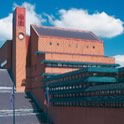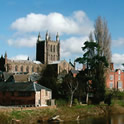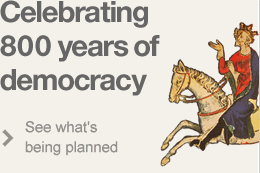The Five “Charter Towns”
City of Canterbury

Canterbury lay in the eye of the storm which began with the accession of Stephen Langton as Archbishop in 1207. He became implacably opposed to King John and in 1213, Archbishop Langton revived the ancient charter of Henry I. This pressure, combined with the military power of the Barons, led directly to the showdown at Runnymede.
Visit Canterbury: http://www.canterbury.co.uk/
City of London

Events that took place in the City of London on Sunday 17th May 1215, became the tipping point in the long-running battle between King John and the Barons. While everyone was at mass, the Barons simply installed their own Mayor, took over the city and then used this as leverage to compel King John to meet them at Runnymede.
Visit London: http://www.cityoflondon.gov.uk
Runnymede

Runnymede may derive from the Anglo-Saxon word “runinge”, meaning to take council and “moed” meaning meadow. Some believe that King Alfred held meetings at Runnymede in ancient times. Travel by boat along the Thames was the standard means of safe transport and the choice of venue would have added additional gravitas to the unfolding drama of Magna Carta, not lost on the recalcitrant King John.
Visit Runnymede: http://www.nationaltrust.org.uk/main/w-runnymede
St Albans

St. Albans earns its place as a Charter Town as on 4 August 1213 Barons and Clergy met at St. Albans Abbey. It was here that the King’s Justiciar agreed to pay compensation for past grievances. These concessions triggered a demand for general rights and privileges, based on the Charter of Liberties of Henry I, which by now had become the template for Magna Carta.
Visit St Albans: http://www.stalbans.gov.uk/leisure-and-culture/tourism-and-travel/
Bury St. Edmunds

Bury St Edmunds has a pivotal role in the history of Magna Carta. One chronicler relates that in 1214 a group of Barons met in St. Edmunds Abbey Church and swore an oath to compel King John to accept The Charter of Liberties, a proclamation of Henry I. It was the direct precursor to Magna Carta a year later.
Visit St Edmundsbury: http://www.stedmundsbury.gov.uk/
or http://www.visit-burystedmunds.co.uk
Magna Carta Original Copies
Lincoln

Lincoln Cathedral has been home to its 1215 Magna Carta, marked twice on the reverse with the word ‘Lincolnia’, for the whole of the last eight centuries, surviving the ravages of the English Civil War. This is appropriate since Hugh of Wells, Bishop of the large and powerful Diocese of Lincoln, was present at Runneymede. It is significant since Archbishop Stephen Langton, the architect of Magna Carta, was a Lincolnshire man who studied ideas of kingship from the manuscripts of Lincoln Cathedral. Whilst Lincoln Cathedral has been its home, Magna Carta has also travelled. It was protected during WWII by the United States who kept it safely in Fort Knox, Kentucky.
Salisbury

The Salisbury Magna Carta is the best preserved of the surviving four examples and is on public view in the Chapter House of the Cathedral of St. Mary - the more correct title of Salisbury Cathedral. This magnificent building, featuring the tallest spire in England, was not the original home of the Magna Carta, but rather the original cathedral built at Old Sarum which was demolished in 1219. The recycled stone was used to build the present cathedral dedicated in 1258.
Visit Salisbury: http://www.visitwiltshire.co.uk/salisbury/home
The British Library

The British Library is the national library of the United Kingdom and one of the world’s greatest libraries. Our collections include more than 150 million items, in over 400 languages, to which three million new items are added every year. We house books, magazines, manuscripts, maps, music scores, newspapers, patents, databases, philatelic items, prints and drawings and sound recordings.
Magna Carta Copies
Durham

Durham Cathedral in Durham City holds three editions of Magna Carta dated 1216, 1225 and 1300. Bishops of Durham held the unique status of Earls Palatine. With a bible in one hand and a bloodied sword in the other, they were effectively warlords who secured England's northern border against Scots ambition.
The Durham Magna Cartas show the evolution of the original. After the death of King John in 1216 Magna Carta was reissued at Bristol by the counsellors of King John's son Henry, then aged nine. The Durham copy is the only one that survives. The 1225 Magna Carta was issued when Henry reached the age of majority and includes a new statement that the charter was issued spontaneously and of the King's own free will. The 1300 Durham copy is the final full issue of Magna Carta, with Edward I now on the throne.
Visit Durham: www.thisisdurham.com
Hereford

Hereford Cathedral boasts a modified version, a third edition of the 1215 Magna Carta, dating from 1217. It was issued by the boy king, Henry III who was 8 years old when his father, King John had a particularly bad day at work two years before. 1217 saw most of England occupied by the French under the usurper Prince Louis, this edition forming part of the subsequent peace treaty. It shows how Magna Carta had become a template for numerous revisions and amendments throughout the following centuries.
Oxford

Oxford’s Bodleian, one of the oldest libraries in Europe, holds three of the surviving manuscripts of the 1217 Charters, the new and improved versions of the original Magna Carta. Issued during the reign of the Henry III when he was only 9 years old, they bear the seal of his appointed guardians - the regents of the boy king, William Marshal and the Papal Legate to England, Guala Bicchieri. The great seal of Henry III was finally attached to an even later edition of the Magna Carta – the 1225 Charter of the Forest.
Featured Article
Magna Carta, or as it is properly called the Great Charter of Liberty, was born on 15 June 1215 at Runnymede when King John – Bad King John as he is more commonly known – was persuaded to accede to a number of demands made...
Read on...Recent Articles
- Magna Carta's American Adventure
- 800th anniversary of Bristol...
- Bristol 800 concert and...
- Emancipation and Magna Carta
- Terrorism and Tolerance -...
- Magna Carta
- Magna Carta Benches mark...
- ABA Magna Carta Memorial...
Stay updated
If you would like to keep informed about the work of the Magna Carta Trust and our partners, please sign up to the newsletter below.
Become a Supporter
There are a number of significant supporter opportunities. Register your interest early to ensure the widest range of options.
Find out more




